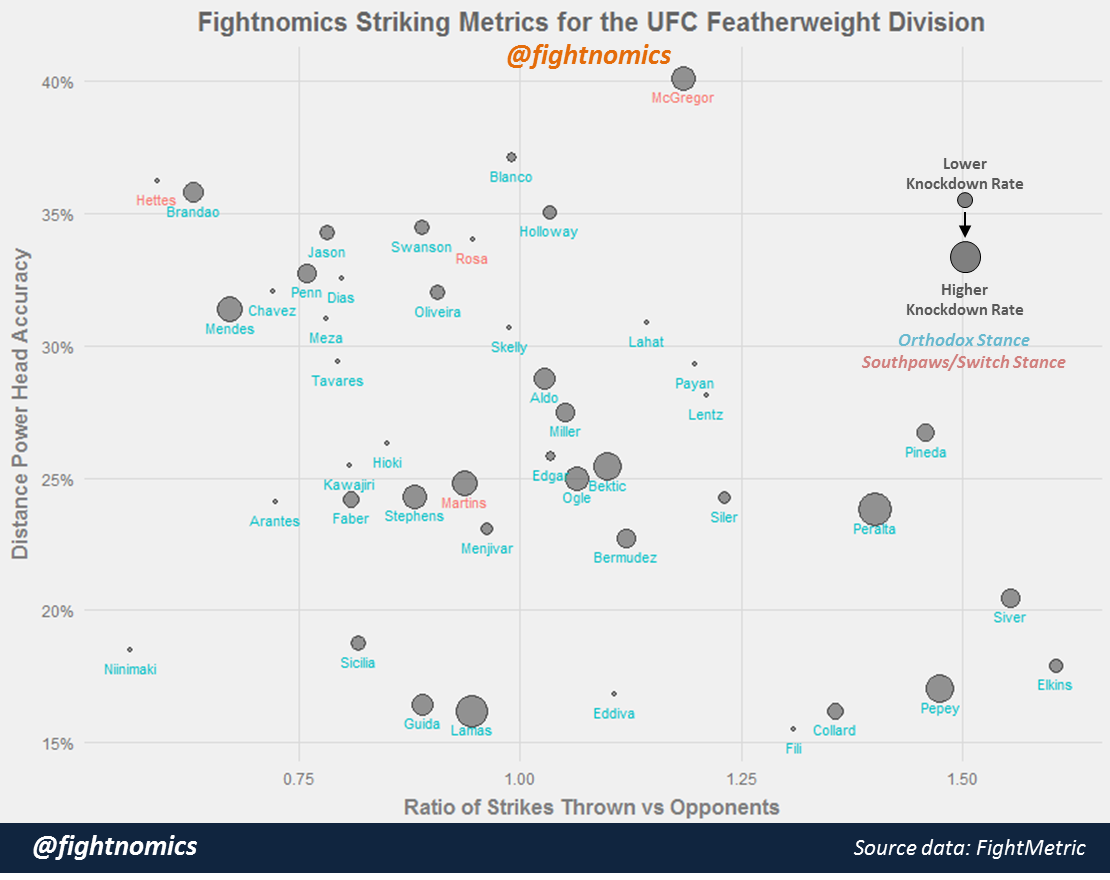By @fightnomics This Sunday in Saskatoon, two young gun Featherweights will face off in the main event. Max Holloway and Charles Oliveira are ranked #5 and #7 respectively, and their young ages belie a wealth of UFC experience. The two fighters are just 23 and 25 years old, yet have 25 combined UFC appearances between them. In fact, they are two of the four youngest fighters ever to become 12-fight UFC veterans. One of these two will clearly remain in the title picture at Featherweight, and both could be contenders further down the road. So that brings our attention to the UFC Featherweight division. For prior analysis of the Light Heavyweight Division, go here. How the Graph Works This balloon (or bubble) chart includes all active UFC Featherweights who have competed since 2013 with sufficient data. Some of the names are clearly retired or no longer with the organization, like BJ Penn, but they were notable enough to leave in here for reference. There’s also a few more that didn’t have enough data, or have been inactive for a while who were excluded. The four metrics in the graph are all related to striking (we’ll look at key grappling stats later). First, the vertical axis is the power head striking accuracy. This is a general reflection of a striker’s skill level in technique. But some fighters are more aggressive than others, while some are primarily counter-strikers, and those characteristics lead to very different striking styles. So the horizontal axis indicates the ratio of strike attempts while standing compared to the same fighter’s opponents. It’s a measure of output, and a proxy for aggression. An even 1.0 ratio means a guy matches the pace of his opponents when standing and trading, while a higher number shows more aggressive and higher-volume strikers compared to lower ratios indicating counter-strikers. The dots are plotted based on those two metrics, but two more variables are also shown. The size of the bubble is based on the fighter’s Knockdown Rate in the UFC/Strikeforce. Bigger bubbles mean a lot more power, while the small specks indicate fighters who haven’t logged a knockdown in recorded competition. And lastly, southpaw/switch stance strikers are in red. Lefties are rare, but are worth highlighting as most fighters have trouble with Southpaws.
Again, we see evidence of the slight negative correlation between volume and accuracy. Counter-strikers are more likely to be snipers, while guys who push forward and throws tons of leather don’t usually connect quite as often. We’ve got a few outliers on this page, but that general relationship does exist. But we also see a pretty good spread of performance metrics here overall, although within reasonable bounds. Power striking accuracy ranges from just over 15% to 40%, evenly straddling the division average of 28%. Meanwhile, all fighters managed to at least throw half as many strikes as their opponents, while none managed to double their opponent output (on average). There are similar numbers of fighters on both sides of the pressure threshold of 1.0. Now that we covered the basics and the big picture, let’s look at some of the fighters who have performed superlatively in these metrics. Snipers Leave it to Conor McGregor to steal the show, even when he’s just a gray circle on a page. McGregor leads the division in his power head strike accuracy at just over 40%, and has managed to do so even while outworking his opponents by 18% on volume, and putting above average power behind his punches. It’s no surprise then that McGregor’s striking has fast-tracked him to a title. Among the veterans ranking highly in strike accuracy, Maximo Blanco, Diego Brandao, Max Holloway, Cub Swanson all deserve honorable mention. High Pressure Strikers Darren Elkins has primarily used his aggressive wrestling to grind opponents down, but when he’s standing he’s similarly relentless. He outworks opponents by more than 60% while standing. While his accuracy is below average, the sheer volume of strikes thrown at opponents may force them to defend high, thus opening the takedown opportunity for Elkins. Among high-pressure strikers who are more accurate than Elkins, Dennis Siver, Robert Peralta, and Daniel Pineda have all be far more aggressive than opponents on average. Sluggers The Featherweight division doesn’t have as many knockout artists as the heavier weight classes, but a few guys deserve mention here. And leading the pack is Robert Peralta, with 6 total knockdowns scored in the UFC and a Knockdown Rate this is much higher than even the average Heavyweight. Also deserving mention is Ricardo Lamas, who while not having tallied as many knockdowns as Peralta, has scored them at a similarly high rate. Further down the list, but still noteworthy among veterans, are both recent interim title challengers Conor McGregor and Chad Mendes. Division’s Next Title Fight The title unification between Conor McGregor and Jose Aldo combines two of the most feared strikers in the division. On paper, McGregor has the accuracy edge, presumably aided by his ridiculously long reach. But in terms of pure striking skill and experience, Aldo definitely presents the toughest challenge yet for McGregor on the feet. They are currently set to face off (finally) at UFC 194 in December. “Fightnomics” the book is now available on Amazon!
